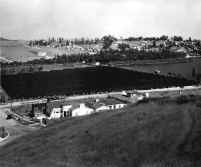
The water is delivered from the LA aqueduct is blended with
groundwater and delivered through the River supply conduit. Ivanhoe acts as a sand
detention pond (those little grains that end up clogging your faucet aerators). The water
then flows over the spillway into Silver Lake. After a final chlorine treatment, the water
is delivered downstream to Elysian Reservoir, downtown and south central Los Angeles.
Silver Lake residents drink water from Eagle Rock Reservoir. The entire, extensive water
delivery system is based on gravity (with a few pumps) and has been designed
conservatively with flexibility and redundancy –should there be outages due to
disasters or water quality conditions.
In 1974, Silver Lake dam was declared unsafe after the 1971
San Fernando Valley earthquake. The lake was drained. It was at this time, the
now-30-year-old Silver Lake Residents Association came
to the fore to defend---so-to-speak---the proposed re-built dam’s location. The DWP
threatened to move the dam to the north up to 600’ with a 10% surface water loss.
Thus began the almost continuous adversarial relationship that existed between the
community and the DWP until 1988 when the final straw was presented -- covering Ivanhoe
and building an on-site, industrial-style filtration plan on the 6 acres on the east side
of Silver Lake near Cove and in front of the Neutra VDL house. At this time, the
single-issue Committee to Save Silver Lake’s Reservoirs was formed and joined with
SLRA and the other reservoir communities to form the Coalition to Preserve Open
Reservoirs.
In 1988, Jim Wickser, fresh from 20 years of Mono Lake
litigation, and the newly appointed Division Head had a novel idea—why not talk to
the community BEFORE a project was planned and perhaps work out a reasonable working
relationship for the benefit of both water quality improvement and the community. So, on
the brink of City-wide litigation, the 10 skeptical reservoir communities formed the
Coalition to Preserve Open Reservoirs (CPOR) and thus, a not-always-agreeable but
certainly better-than-litigation relationship was born and in the 10 years since the
formal Mediation began, our community has benefited, as has the DWP. The repaving of
Ivanhoe project included new sprinklers and landscaping as well as continuing monitoring
of the stressed Aleppo Pines. Because our reservoir sides are paved, we don’t fall
under the current Surface Water Treatment Rule that is requiring Stone, Hollywood and
Encino Reservoirs to plan major projects in order to comply.
Someday, we will probably have to face this issue again, but
for right now, there are no plans to cover Ivanhoe and build the filtration plant on site.

Ivanhoe Reservoir with a cover, c. 1930s
Visit more
reservoir photos
|

